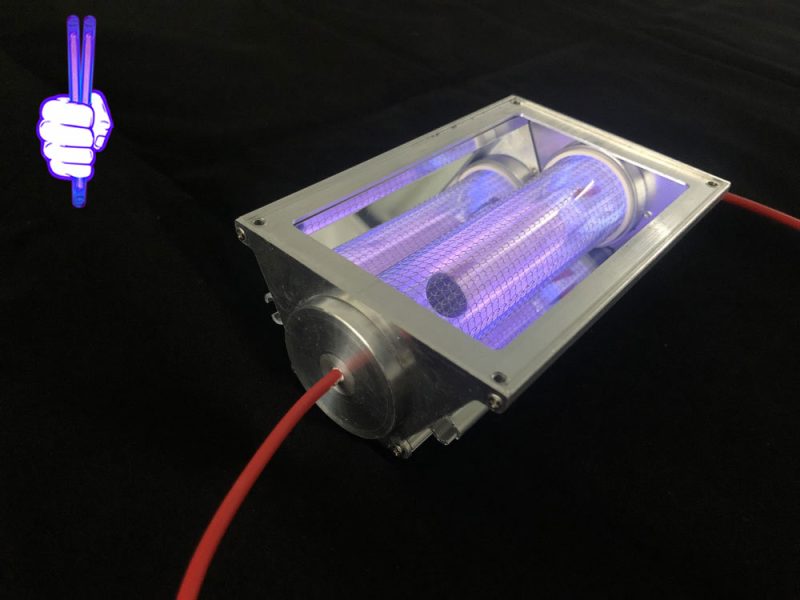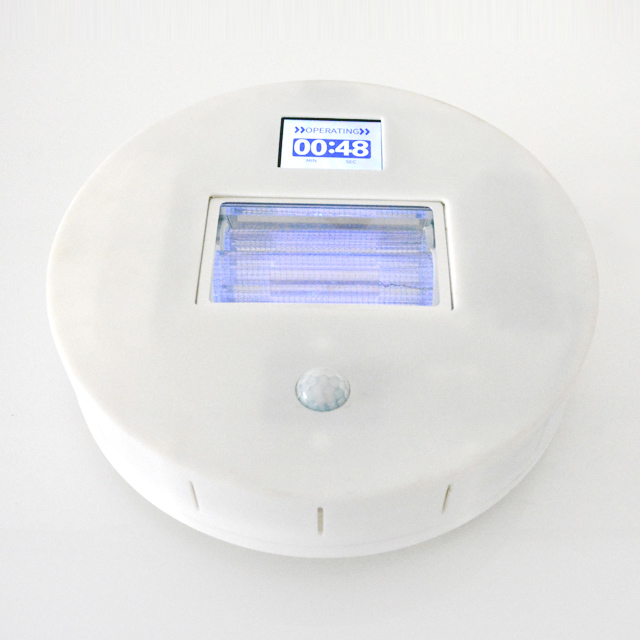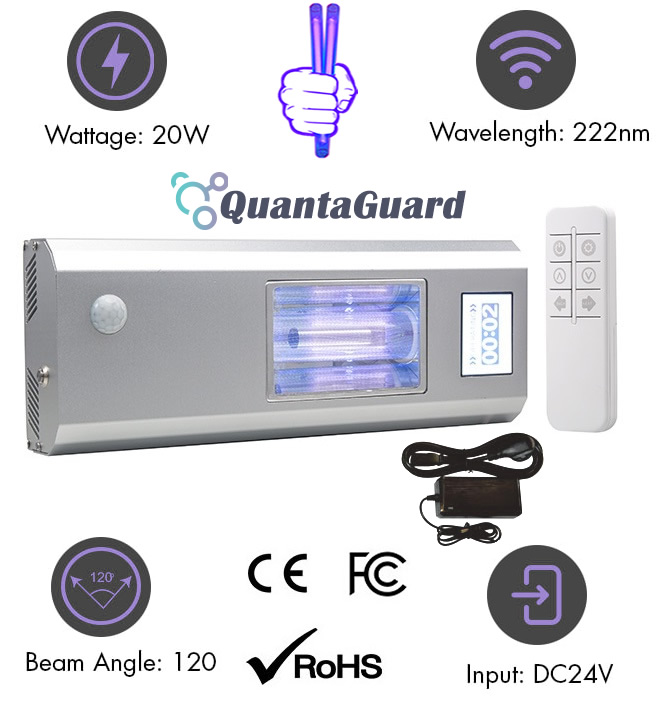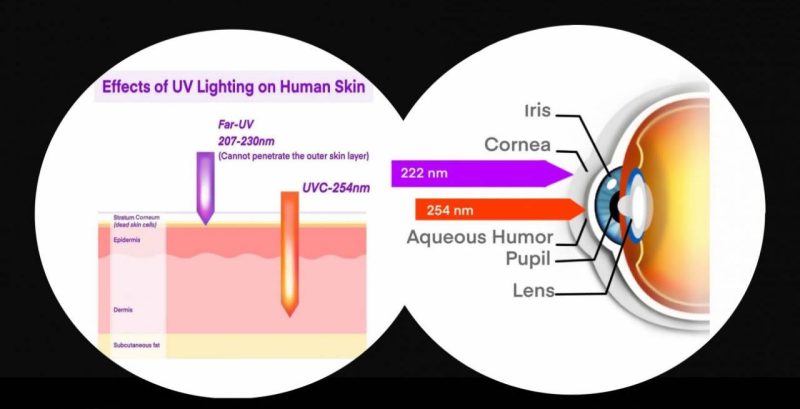Airborne-mediated microbial diseases such as influenza and tuberculosis represent significant public health challenges. A direct approach to prevent airborne transmission is the inactivation of airborne pathogens such as Coronavirus. The airborne antimicrobial potential of UVC ultraviolet light has long been established; however, its widespread use in public settings is limited because conventional UVC light sources are both carcinogenic and cataractogenic.
However, a breakthrough has proven that far-UVC light (207-222 nm) efficiently inactivates bacteria without harming exposed mammalian skin. https://faruv.lighting/
Due to its strong absorbance in biological materials, far-UVC light cannot penetrate even the outer (nonliving) layers of human skin or eye; however, bacteria and viruses are of micrometer or smaller dimensions, and far-UVC can penetrate and inactivate them.
For the first time in history, people can now use far-UV to safely and efficiently inactivate airborne aerosolized viruses, with a very low dose of only two mJ/cm2 at 222-nm light; Far-UV was first proven to work by inactivating aerosolized H1N1 influenza virus.
Far-UVC light manufacturers and Far UV companies now have much greater flexibility in designing products with the compact, preassembled Far-UVC QuantaModule 222-nm Far-UVC Light for sale in 5 Watts, 15 Watts, and 20 Watts. Far-UVC light manufacturers create lights for cutting-edge AP-UVGI (Active Personnel Ultraviolet Germicidal Irradiation). Far-UVC light cancer isn’t a concern because the filtered far-UVC wavelengths can’t reach the DNA of living human cells.
Far-UVC Light Manufacturers (FarUV.Lighting)
FAR UVC Light Manufacturers in the USA
- Far UV Innovations: USA Manufacture of Far UVC Solid-state Devices
- Far UV Solutions: USA Manufacture of Far-UVC Excimer Flat Lamps (Tiles) and 222nm Bulbs (Tubes)
- Hygeia UV: Far UVC Autonomous Robot For Effective AI-Powered Cleaning Solutions
- Sterilray: USA Far-UVC Light Manufacturer of 222nm Excimer Lamps
- Eden Park: USA Far-UVC Light Manufacturer of 222nm Microcavity Thin Flat Plasma Lamps
- NS Nanotech: USA 219nm Far-UVC LED Manufacturer of Solid-state narrow-band Far-UVC
- Ushio USA: Far-UVC Light Manufacturer of 222nm Excimer Lamps
- Far UV Technology: USA Far-UVC Light Design Manufacturer
- Larson Electronics: USA Far-UVC Light Design Manufacturer
FAR UVC Light Manufacturers in China
- FirstUVC: Far-UVC Light Manufacturer of 222nm Excimer Lamps
FAR UVC Light Manufacturers in Japan
- Ushio Japan: Far-UVC Light Manufacturer of 222nm Excimer Lamps
- Sony: 222nm Far-UVC LED (Laser Diode) Manufacturer of Solid-state
The highest standards are used to manufacture QuantaBulbs in an ISO9001 Far-UVC light manufacturing plant (Quality Management System) delivered by the Agency for International Standardization.
Excimer 222 nm Far-UVC Light Bulbs Require Band-Pass Filtering For AP-UVGI (Active Personnel Ultraviolet Germicidal Irradiation) Applications!
Filtered Far-UVC Excimer QuantaBulbs should always be combined with other measures, like wearing face masks, distancing, and washing hands, to limit virus transmission.
The most common way to manufacture Far–UVC 222 nm light is by using high-frequency discharge excimer lamps filled with a mixture of noble gas molecule krypton (Kr) and usually less than 3% chloride (Cl) gas. These excited Kr/Cl emissions peaks of 222 nm from excimer lamps eliminate the use of hazardous materials like mercury and allow for near full power operation in only seconds, compared to several minutes with legacy UVGI mercury vapor UVC lamps.
Far-UVC light created by excited noble gas provides the exact excimer lamp Far-UVC-light peak wavelengths necessary for AP-UVGI (Active Personnel Ultraviolet Germicidal Irradiation) Far UV lighting applications, using a very narrow frequency band of EMR (Electro-magnetic Radiation) found to be human-safe at between 207nm, and 222nm wavelengths in a narrow band part of the electromagnetic spectrum referred to as Far-UVC light, which is generated by exciting KrCl molecules inside various power and wattage excimer Far-UVC light bulbs.
QuantaBlubs 222nm Far-UVC light Bulb Wattage Availability
5-Watt || 15-Watt || 20-Watt || 40-Watt || 60-Watt || 100-Watt || 150-Watt || 1000-Watt
QuantaModule 222 nm Far-UVC Light Kit Modules – B1-5W / B2-15W / B3-20W
Filtered Far-UVC Excimer QuantaModule Lamp Kit

Figuring out the right amount of Far-UVC power and filtering longer wavelengths for occupied spaces and how to best design a Far-UV light system shouldn’t be left up to anyone who isn’t fully trained in Far-UV light disinfection technology.
Most scientists and engineers in the UV business now use the units “mJ/cm2” (millijoule per square centimeter) or “J/m2” (joule per square meter) for UV dose (the correct term is “fluence”). The units “J/m2” are used in most parts of the world except for North America, where “mJ/cm2” is used (1 mJ/cm2 = 10 J/m2. The old term “mW-s/cm2” (milliwatt-second per square centimeter) is equivalent to “mJ/cm2” since a “W-s” is the same as a “J” (joule). Note that 1000 microwatt = 1 milliwatt.
The units “mW/cm2” (for fluence rate or irradiance) is often confused with the unit “mJ/cm2” (for fluence or UV dose). This is because the “fluence” (UV dose) is obtained by multiplying the “fluence rate” (or irradiance) (units “mW/cm2”) by the exposure time in seconds.
A continuous, very low dose rate of far-UV light in indoor public locations is a promising, safe, and inexpensive tool to reduce the spread of airborne-mediated microbial diseases.
2020 was a year of great despair, forcing us to reconsider the old ways. But, unfortunately, 2020 is also going down as the year outdated UVGI (Ultraviolet Germicidal Irradiation) technology made room for its predecessor — AP-UVGI (Active Personnel Ultraviolet Germicidal Irradiation), because this new AP-UVGI technology is completely safe for human occupants while destroying viruses in real-time in the presents of people.
The old way of using UVGI hasn’t changed much since its inception to prevent airborne disease by Wells in the early 1900s. Therefore, Quanta X Technology has made it a vital mission to finish William Firth Wells’ work which pioneered UVGI innovation 100 years ago and is still widely used today in healthcare settings just as it was a century ago.
We are confident if Wells were alive today, he would be shocked at the slow rate of innovation UVC manufactures have built on his discoveries using Germicidal Irradiation, that is, until now! AP-UVGI technology, Far UVC light companies have innovated UVGI more in the past 12 months than has occurred over the last decade. Active Personnel Ultraviolet Germicidal Irradiation, or simply AP-UVGI, the substitution of human-safe Far-UVC light replacing conventional mercury-line UVGI Ultraviolet-C light, is the most disruptive technology-based non-pharmaceutical pandemic countermeasure in human history.
Current UVGI depends on UVC light wavelengths that destroy RNA/DNA viruses and harm human cells when exposed to the most commonly used mercury line 253.7nm UVGI peak wavelength.
Using current UVGI makes an area inaccessible to people during a standard UVGI Ultraviolet-C light disinfection process.
It doesn’t take a rocket scientist to figure out airborne transmission in an empty room isn’t a threat, and with UVGI, when the people return to a disinfected space, the danger of airborne spread returns with them! AP-UVGI targets active bio-agent threats when there is a real risk of airborne spread in occupied areas.
The higher frequency in AP-UVGI technology increases the photons’ energy responsible for neutralizing airborne bio-hazards and human safety by orders of magnitude over conventional UVGI. In addition, new AP-UVGI technology delivers these higher energy photons with a corresponding wavelength that studies have shown does not harm the skin or the eyes.
More precisely, within an infinite range of EM frequencies, the most significant advantage is that AP-UVGI uses a tiny “sweet spot” of EMR (Electromagnetic Radiation), completely safe for human exposure. This Far-UVC wavelength sweet spot that Dr. David Brenner brought to light is located in an extremely narrow part of Far-UVC’s section of the electromagnetic spectrum between peak 207-222nm wavelengths. Such a breakthrough now allows for Active Personal to be in the area being disinfected in real-time using only nature’s invisible shortwave Far-UVC light for extremely effective human-safe Ultraviolet Germicidal Irradiation.
AP-UVGI
Active Personnel Ultraviolet Germicidal Irradiation

The most commonly used lights have a wavelength of 254 nanometers (nm), which has a relatively short UV wavelength—the so-called “C” category—but can penetrate the skin and eyes, leading to cancer and cataracts. For the past four years, a group led by physicist David Brenner at Columbia University Medical Center in New York City has tested shorter wavelengths, known as “far UVC light,” that can’t penetrate the outer layers of the eyes or skin. The researchers found that Far UVC eliminated bacteria on surfaces and did not harm lab mice.
Complete QuantaGuard filtered excimer lamp 222nm Far-UVC light assembly with remote control, motion sensor, loop LED display timer, and 24V power supply is available in three QuantaGuard excimer lamp models: 5-Watt, 15-Watt, and 20-Watt. Seen below.

The invention increases the safety of staff, patients, and their relatives by reducing the risk of contact with bacteria, viruses, and other harmful microorganisms. The concentrated Far-UV-C light emitted has a powerful yet safe germicidal effect that removes virtually all airborne viruses and bacteria on a room’s surfaces.
QuantaGuard™ has chosen First-UVC as their official ISO9001 Excimer Far-UV Light Manufacture (quality management systems) delivered by the Agency for International Standardization. To provide the highest-quality Far-UV light products globally, a battery of testing includes but is not limited to: Microbiological Effectiveness Test, IEC62471 (photobiological safety inspection), BACL ( 222m, wavelength test), and CE, FCC, RoHS Certifications.
Make sure your First-UVC choice is always QuantaGuard™ for all your Far-UV lighting needs!

